Op weg naar TiO2-nanovloeistoffen - Deel 2:Toepassingen en uitdagingen
Abstract
Het onderzoek naar nanovloeistoffen is explosief toegenomen vanwege hun fascinerende eigenschappen in warmte- of massatransport, vloeibaarheid en dispersiestabiliteit voor toepassingen in energiesystemen (bijvoorbeeld zonnecollectoren, koeling, warmtepijpen en energieopslag). Dit tweede deel van de review vat recent onderzoek samen naar de toepassing van TiO2 nanovloeistoffen en identificeert de uitdagingen en kansen voor de verdere verkenning van TiO2 nanovloeistoffen. De verwachting is dat de twee uitgebreide beoordelingen een nuttige referentiegids kunnen zijn voor onderzoekers om de kennis over de onderzoeksstatus van TiO2 bij te werken. nanovloeistoffen, en de kritische opmerkingen, uitdagingen en aanbevelingen kunnen nuttig zijn voor toekomstige studierichtingen.
Recensie
Achtergrond
In het eerste deel zijn de onderzoeken naar de bereiding, stabiliteit en eigenschappen besproken. Het is te zien dat er veel onderzoek is gedaan naar de bereidingsrichtingen en eigenschappen van nanovloeistoffen [1,2,3,4,5,6,7]. Ondertussen zijn er ook veel pogingen gedaan om nanovloeistof toe te passen, vooral in energiesystemen [8,9,10,11]. Vanwege de verbetering van het warmte- en massaoverdrachtsproces, is TiO2 nanovloeistoffen zijn voorlopig toegepast op het gebied van zonnecollectoren [12], koeling [13,14,16], energieopslag [17, 18], warmtepijpen [19,20,21] en andere energietoepassingen [22,23 ,24,25,26,27,28,29,30,31,32,33,34], zoals autoradiator [31], PV/T hybride systeem [32, 33] en warmtekrachtkoppeling (WKK ) systemen [34]. In onze eerdere studies waren de warmteoverdrachtskarakteristieken van TiO2 nanovloeistoffen in warmtegeleiding, geforceerde convectie kokende warmteoverdracht en natuurlijke convectiewarmteoverdracht zijn samengevat [35]. Het is echter verre van een uitgebreide samenvatting voor de toepassing van TiO2 nanovloeistoffen; er zijn ook veel praktische toepassingen voor TiO2 nanovloeistoffen. Hier, in deel 2, zullen we een gedetailleerd overzicht geven van de thermische geleidbaarheid en energiegerelateerde toepassingen van TiO2 nanovloeistoffen. We hopen dat de twee beoordelingen in combinatie met ons vorige rapport [35] een uitgebreid inzicht kunnen bieden in de onderzoeksvoortgang van TiO2 nanovloeistoffen. Met de ontwikkeling van nanovloeistoftechnologie wordt verwacht dat nanovloeistoffen praktisch zullen worden toegepast als een nieuwe en efficiënte werkvloeistof voor die energiesystemen.
Toepassing bij het verbeteren van de thermische geleidbaarheid
Aangezien de uitstekende prestaties van nanovloeistoffen over het algemeen worden toegeschreven aan de fysieke eigenschappen van vloeistoffen met de toevoeging van nanodeeltjes, zou het experimentele of theoretische onderzoek naar de thermische geleidbaarheid van nanovloeistoffen een belangrijk onderwerp moeten zijn op het gebied van nanovloeistoffen. Hoewel de meeste overzichtsartikelen de thermische geleidbaarheid introduceerden in het fysieke eigenschapsgedeelte, is het verbeteren van de thermische geleidbaarheid ook een belangrijk toepassingsaspect van nanovloeistoffen. Een andere reden om thermische geleidbaarheid in het toepassingsgedeelte te plaatsen, is om de inhoud van de twee beoordelingen in evenwicht te brengen.
Veel experimentele en theoretische onderzoeksresultaten hebben aangetoond dat de toevoeging van nanodeeltjes de thermische geleidbaarheid van vloeistof duidelijk kan verbeteren. De invloedsfactoren op de thermische geleidbaarheid van nanovloeistoffen kunnen worden geïnduceerd als de volgende groepen:(1) interne factoren, waaronder het type deeltjes, inhoud [36, 37], grootte [38], vorm [39] en structuur [40] en type basisvloeistof [41] en waarschijnlijke oppervlakteactieve stof of pH-regelaar [42, 43] indien aanwezig; (2) externe factoren, waaronder temperatuur [40], supersonische trillingstijd [44], opslagtijd [45] of looptijd [46]; en (3) microkosmische factoren, zoals oppervlakteladingstoestand van nanodeeltjes [47], cluster van deeltjes [48], de grensvlak nanolaag [49], Brownse beweging [50], de aggregatie [51], grensvlak thermische weerstand en massa verschilverstrooiing [52]. Onze eerdere studie heeft een tabel opgeleverd om de thermische geleidbaarheid van TiO2 . aan te tonen nanovloeistoffen [35]. Het is echter niet intuïtief en lastig om de verschillende effectfactoren op de invloedsgraad te begrijpen. Daarom, in dit deel 2, de invloeden op de thermische geleidbaarheid van TiO2 nanovloeistoffen worden in cijfers weergegeven om een meer perceptueel begrip te bieden.
Effect voor het laden van deeltjes
Een samenvatting van de toename van de thermische geleidbaarheid van TiO2 -water nanovloeistoffen met de volumefractie van nanodeeltjes in de beschikbare literatuur wordt getoond in Fig. 1. Uit alle experimentele resultaten blijkt dat TiO2 nanodeeltjes kunnen de thermische geleidbaarheid van basisvloeistoffen verbeteren. De stappen van verschillende onderzoeken zijn echter grondig verschillend. Een verbetering van de thermische geleidbaarheid van nanovloeistoffen is bijvoorbeeld ongeveer 2-4 keer de volumebelading van TiO2 nanodeeltjes, waaronder Masuda et al. [53], Turgut et al. [54], Zhang et al. [55], Wang et al. [56], Pak en Cho [57], Yang et al. [58], en de resultaten van Musshed et al. [59]. De andere verbetering kan 6-20 keer volumelading van TiO2 . bereiken nanodeeltjes, waaronder Yoo et al. [60], Wen en Ding [61], Musshed et al. [62], Hij et al. [63], Chen et al. [64], en de resultaten van Saleh et al. [65].
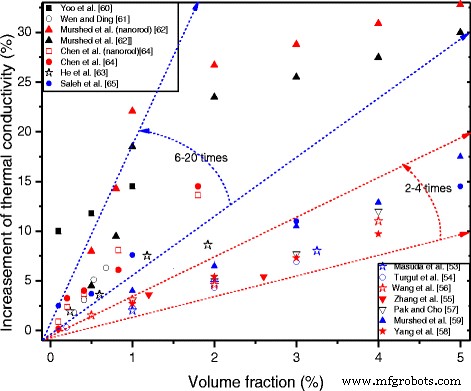
Volumefractie-afhankelijkheid van thermische geleidbaarheid van TiO2 –water nanovloeistoffen in beschikbare literatuur
De verschillen in resultaten zijn waarschijnlijk het gevolg van, naast de volumefracties, de thermische geleidbaarheid van TiO2 nanovloeistoffen worden ook bepaald door de parameters van de deeltjes en de omgevingsomstandigheden, zoals deeltjesgrootte en vorm, oppervlakteactieve stof, pH-waarde en temperatuur, die in verschillende werken behoorlijk verschillend waren. Bovendien merkten sommige onderzoekers op dat nanodeeltjes weinig effect hebben op de thermische geleidbaarheid van TiO2 nanovloeistoffen. Utomo et al. [66] onderzocht de thermische geleidbaarheid van op water gebaseerde aluminiumoxide en titanium nanovloeistoffen. Ze merkten op dat de thermische geleidbaarheid van TiO2 nanovloeistoffen die ze bereidden, was iets lager dan de conventionele modelvoorspelling vanwege het hoge gehalte aan dispergeermiddelen. En de resultaten toonden duidelijk aan dat TiO2 nanovloeistoffen vertonen geen abnormale verbetering van de thermische geleidbaarheid of convectiewarmteoverdrachtscoëfficiënt in een pijpstroom, zoals aangetoond in andere rapporten.
Deeltjevormeffect
De invloeden van vorm en grootte van nanodeeltjes zijn niet zo uitgebreid onderzocht als die van deeltjeslading. De bestaande onderzoeken hebben geen grote effecten aangetoond van de vorm of grootte van de deeltjes op de thermische geleidbaarheid van TiO2 nanovloeistoffen, wat hoogstwaarschijnlijk te wijten is aan de relatief kleine hoeveelheden op dit effect. Murshed et al. [62] verspreidde twee soorten TiO2 nanodeeltjeswater met CTAB als dispergeermiddel. Eén type is in staafvorm met een lengtediameter van 10 nm × 40 nm. En het andere type is in bolvormen met een diameter van 15 nm. Ze merkten op dat de thermische geleidbaarheid van beide soorten TiO2 nanovloeistoffen namen toe met de toename van de deeltjeslading, terwijl de staafachtige deeltjes meer bijdragen hadden dan bolvormige. De maximale verbeteringen in de thermische geleidbaarheid voor de eerste en de laatste waren respectievelijk ongeveer 33 en 30%. Chen et al. [64] bestudeerde de effectieve thermische geleidbaarheid van vier soorten nanovloeistoffen die orthogonaal zijn gemaakt van TiO2 nanodeeltjes (25 nm) en TiO2 nanobuisjes (10 nm × 100 nm) met respectievelijk water en EG als basisvloeistof. Ze ontdekten dat de verschillen tussen de verbetering van TiO2 nanodeeltjes en TiO2 nanobuisjes op de thermische geleidbaarheid waren niet groot, terwijl de verbetering veel groter is dan de berekeningswaarde van de Hamilton-Crosser-vergelijking.
Temperatuureffect
Temperatuur is een andere belangrijke invloedsfactor op de thermische geleidbaarheid van TiO2 nanovloeistoffen. Afbeelding 2 toont de invloed van temperatuur op de verbetering van de thermische geleidbaarheid van TiO2 nanovloeistoffen in verschillende onderzoeken. Wang et al. [67] onderzocht het effect van deeltjeslading en temperatuur op de thermische geleidbaarheid van TiO2 op waterbasis nanovloeistoffen. De resultaten toonden aan dat de werktemperatuur een belangrijkere positieve rol speelt en meer bijdraagt aan de thermische geleidbaarheid bij een hogere temperatuur. Ze concludeerden ook dat de resultaten overeenkwamen met de theoretische waarden die werden bepaald door rekening te houden met de temperatuurafhankelijke Brownse beweging en de microconvectie. Reddy et al. [68] onderzocht de thermische geleidbaarheid van TiO2 nanovloeistoffen voor verschillende deeltjeslading in het bereik van 0,2-1,0% bij verschillende temperaturen. En ze merkten op dat de thermische geleidbaarheid van TiO2 nanovloeistoffen neemt toe met een toename van zowel de deeltjesbelasting als de temperatuur. Yang et al. [58] TiO2 . toegevoegd nanodeeltjes tot ammoniak-water om op binaire vloeistof gebaseerde nanovloeistoffen te bereiden. Ze ontdekten ook dat de temperatuurstijging zou kunnen resulteren in een toename van de thermische geleidbaarheidsverhouding van binair TiO2 nanovloeistoffen naar basisvloeistof.
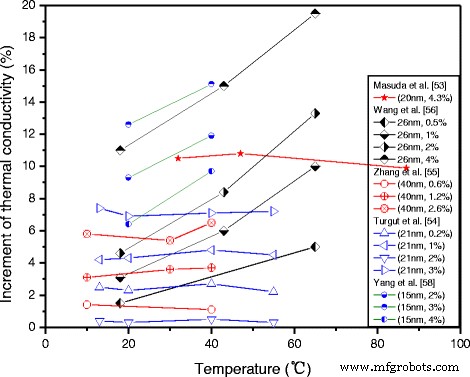
Invloed van temperatuur op de verbetering van de thermische geleidbaarheid van TiO2 nanovloeistoffen in verschillende onderzoeken
De bovenstaande resultaten toonden aan dat TiO2 nanodeeltjes kunnen meer bijdragen aan de thermische geleidbaarheid van TiO2 nanovloeistoffen bij hogere temperatuur. Er kunnen echter ook enkele unieke resultaten over het effect van temperatuur worden opgenomen. Turgut et al. [54] onderzocht de effectieve thermische geleidbaarheid van gedeïoniseerd TiO2 . op waterbasis nanovloeistoffen bij temperaturen van 13, 23, 40 en 55 °C. Ze merkten op dat de thermische geleidbaarheid toeneemt met een toename van de deeltjesbelasting, maar de verandering van temperatuur heeft weinig effect op de effectieve thermische geleidbaarheid van TiO2 nanovloeistoffen. Bovendien toonden enkele resultaten aan dat temperatuur een rol speelt bij de effectieve thermische geleidbaarheid. Duangthongsuk en Wongwises [69] geschorst TiO2 nanodeeltjes in water met een volumebelastingsbereik van 0,2 tot 2%, en ze verzamelden de gegevens bij een temperatuurbereik van 15 tot 35 °C. Ze merkten op dat de gemeten thermische geleidbaarheid van TiO2 -water nanovloeistoffen namen toe met de toename van zowel de deeltjesbelasting als de temperatuur, maar de thermische geleidbaarheidsverhouding nam af wanneer de temperatuur toenam; ze schreven de reden toe aan de snellere groeisnelheid van thermische geleidbaarheid van basisvloeistof.
De reden van de onzekere rol van temperatuur op de thermische geleidbaarheidsverhouding van TiO2 nanovloeistoffen kunnen te wijten zijn aan het complexe mechanisme van thermische geleidbaarheid van nanovloeistoffen. Wanneer de temperatuur verandert, kunnen de andere parameters, zoals de structuur, oppervlakteactiviteit, stabiliteit en van deeltjes, de eigenschap van dispergeermiddel, enz. worden gewijzigd, en die parameters zijn over het algemeen veel verschillend in verschillende werken. Daarom zijn de invloeden van temperatuur op de thermische geleidbaarheidsverhouding van TiO2 nanovloeistoffen zijn gerelateerd aan de specifieke nanodeeltjes en basisvloeistoftypes. Deze waarneming kan verder worden verbeterd door het onderzoek van Cabaleiro et al. [41], waarin het temperatuurafhankelijke thermische geleidbaarheidsgedrag werd bestudeerd voor anatase en rutiel TiO2 nanovloeistoffen met respectievelijk ethyleen en propyleenglycol als basisvloeistof. De temperatuurafhankelijkheid van de thermische geleidbaarheid van deze vier soorten TiO2 nanovloeistoffen wordt getoond in Fig. 3. Het kan worden waargenomen dat alle vier soorten nanovloeistoffen hogere thermische geleidbaarheid vertoonden dan de overeenkomstige basisvloeistoffen. Temperatuur speelde verschillende rollen voor TiO2 nanovloeistoffen met verschillende nanokristallijne structuur nanodeeltjes en met verschillende basisvloeistoffen. De thermische geleidbaarheid nam toe naarmate de temperatuur stijgt voor op EG gebaseerde nanovloeistoffen, met een maximale toename van 11,4% met de temperatuur in het onderzoeksbereik, terwijl het bijna onafhankelijk leek van de temperatuur voor op PG gebaseerde nanovloeistoffen.
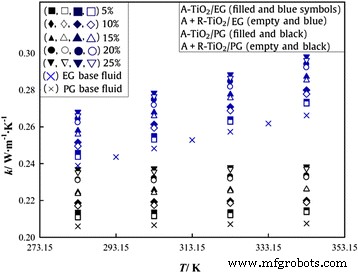
Temperatuurafhankelijkheid van de thermische geleidbaarheid van vier soorten TiO2 nanovloeistoffen [41]. Overgenomen met toestemming van Elsevier
Basisvloeistofeffect
Ingrediënten van basisvloeistoffen kunnen ook de thermische geleidbaarheid van TiO2 . beïnvloeden nanovloeistoffen. Chen et al. [64] gemeten de effectieve thermische geleidbaarheid van sferische en buisvormige TiO2 nanovloeistoffen met respectievelijk water en ethyleenglycol als basisvloeistoffen. Ze merkten op dat beide verbeteringen van TiO2 nanodeeltjes en TiO2 nanobuisjes met EG als basisvloeistof waren hoger dan die met water als basisvloeistof. Reddy et al. [68] ontdekte dat de verbetering van de thermische geleidbaarheid voor TiO2 op waterbasis, EG/W (40%:60%) en EG/W (50%:50%) nanovloeistoffen stegen van respectievelijk 0,649 tot 5,01%, 1,94 tot 4,38% en 10,64 tot 14,2% wanneer de volumeconcentratie van TiO2 nanodeeltjes namen toe van 0,2 tot 1,0% bij kamertemperatuur (30 ° C). Er kunnen echter ook enkele tegengestelde resultaten worden waargenomen, Cabaleiro et al. [41] ontdekte dat de thermische geleidbaarheidsverbeteringen voor TiO2 nanovloeistoffen met EG, PG of paraffineolie als basisvloeistof waren duidelijk lager dan die met water als basisvloeistof. Ook werd in het rapport van Sonawane et al. [70] gedacht dat het effect van basisvloeistoffen complex en ontoegankelijk is omdat de thermische geleidbaarheid van TiO2 nanovloeistoffen met 1 vol.% deeltjeslading volgden de volgende volgorde:op paraffineolie gebaseerde nanovloeistof> op water gebaseerde nanovloeistof> op EG gebaseerde nanovloeistof, terwijl die van zuivere basisvloeistoffen de volgorde water> EG> paraffineolie volgde. Ze analyseerden deze grillige observatie vanuit het perspectief van het viscositeitseffect en dachten dat een lagere viscositeit van de basisvloeistof meer zou kunnen bijdragen aan de verbetering van de thermische geleidbaarheid van nanovloeistoffen.
Oppervlakteactieve stof
De toevoeging van oppervlakteactieve stof is een andere belangrijke factor voor de thermische geleidbaarheid van TiO2 nanovloeistoffen. Sommige resultaten toonden aan dat de oppervlakteactieve stoffen een positief effect hebben op de thermische geleidbaarheid. Saleh et al.'s [65] bestudeerden het effect van verschillende soorten oppervlakteactieve stoffen op de thermische geleidbaarheid van TiO2 -water nanovloeistoffen, en de resultaten worden getoond in Fig. 4. Het is te zien dat alle drie soorten oppervlakteactieve stoffen de thermische geleidbaarheid van nanovloeistoffen aanzienlijk kunnen verbeteren en de nanovloeistoffen met SDS als stabilisator vertoonden de grootste verbetering, gevolgd door die met CTAB en Span-80 als stabilisator. En ze dachten dat de dispersiestabiliteit en oppervlakte-eigenschappen van de deeltjes betrokken waren bij de verbeteringen in thermische geleiding van nanovloeistoffen.
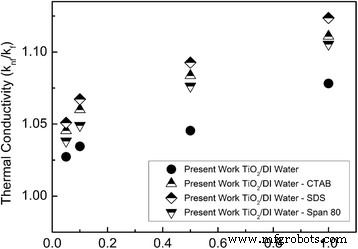
Effect van verschillende oppervlakteactieve stoffen op de thermische geleidbaarheid van TiO2 –water nanovloeistoffen [65]. Overgenomen met toestemming van Elsevier
Er zijn ook enkele verschillende resultaten over het oppervlakteactieve effect. Yang et al. [58] ontdekte dat wanneer het gehalte aan ammoniak in basisvloeistoffen toeneemt, de thermische geleidbaarheidsverhouding van TiO2 nanovloeistoffen zullen ook toenemen omdat de stabiliteit van TiO2 ammoniak-water nanovloeistoffen zullen worden verbeterd in hogere pH-waarde. En de oppervlakteactieve stoffen PEG1000 en PAA in lage concentratie hebben een relatief kleinere invloed dan andere invloedsfactoren op de thermische geleidbaarheid, zoals het deeltjes- of ammoniakgehalte, de temperatuur. PEG1000 kan echter de stabiliteit verbeteren TiO2 ammoniak-water nanovloeistoffen, die de thermische geleidbaarheid van nanovloeistoffen verbeteren. Murshed et al. [62] ontdekte dat oliezuur en CTAB de dispersiestabiliteit van TiO2 kunnen verbeteren nanovloeistoffen zonder de thermische fysische eigenschappen van nanovloeistoffen en eenfasige warmteoverdrachtscoëfficiënt te beïnvloeden, omdat het gehalte aan oppervlakteactieve stoffen dat in hun experimenten werd gebruikt, zeer laag was, namelijk. 0,01-0,02 vol.%. Er zijn ook enkele resultaten die aantoonden dat de oppervlakteactieve stoffen een deprimerend effect hebben. Utomo et al. [66] onderzocht de thermische geleidbaarheid van Al2 . op waterbasis O3 en TiO2 nanovloeistoffen. Ze ontdekten dat een hoge belasting van stabilisatoren zou kunnen leiden tot een afname van de effectieve thermische geleidbaarheid van die twee soorten nanovloeistoffen.
Sonicatie-effect
De sonicatie toonde ook enkele effecten op de thermische geleidbaarheid van TiO2 nanovloeistoffen. Ismay et al. [71] ontdekte dat de thermische geleidbaarheid van TiO2 -water nanovloeistoffen bereikten het maximum wanneer de pH-waarde dicht bij 7 ligt en werd verder verbeterd door 2 uur ultrasoonapparaat. En ze dachten dat aggregatie de waargenomen verbeteringen als gevolg van het percolatie-effect zou kunnen verklaren. Sonawane et al. [70] heeft specifiek onderzoek gedaan naar het effect op de thermische geleidbaarheid door de ultrasone tijd, en de resultaten worden getoond in Fig. 5a-c. Het kan worden gevonden voor alle drie soorten nanovloeistoffen in verschillende concentraties, de toenemende proporties van thermische geleidbaarheid namen eerst toe en namen vervolgens af naarmate de ultrasone tijd toeneemt, en de maximale toename vond plaats bij de sonicatietijd van 60 minuten. Ze schreven de reden als volgt toe:een optimale sonicatietijd van 60 minuten kan de Brownse beweging van nanodeeltjes en de intermoleculaire interactie tussen deeltjes en bulkvloeistof intensiveren, wat resulteerde in een verbetering van de thermische geleidbaarheid. Langdurige sonicatie van meer dan 60 minuten zou echter de clustering en aggregatie van nanodeeltjes kunnen veroorzaken, wat verantwoordelijk werd geacht voor de afname van warmtetransport en thermische geleidbaarheid in nanodeeltjes.
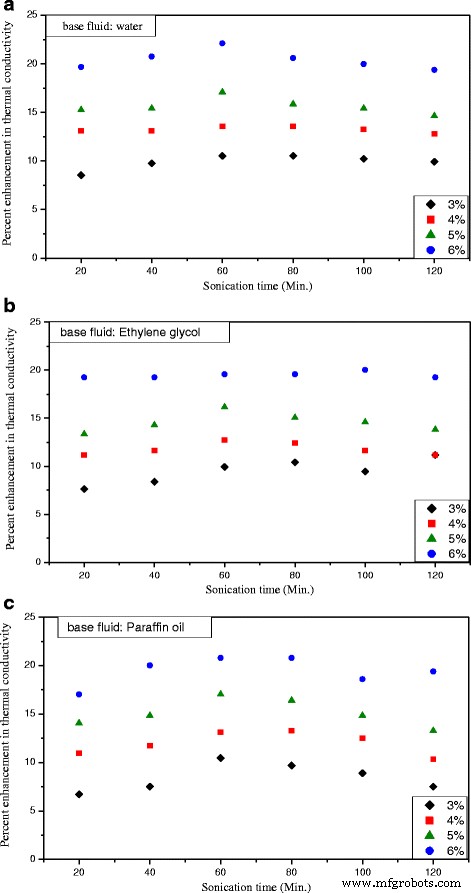
De procentuele verbetering van de thermische geleidbaarheid als functie van de sonicatietijd. een Basisvloeistof:water. b Basisvloeistof:ethyleenglycol. c Basisvloeistof:paraffineolie. Opnieuw getekend op basis van experimentele gegevens in referentie [70]
Theoretische studies
De theoretische studie van nanovloeistoffen is een van de onderzoekshotspots op het gebied van nanovloeistoffen. Er zijn de afgelopen jaren tal van thermische geleidbaarheidsmodellen voorgesteld. Algemeen wordt aangenomen dat de meeste conventionele modellen kunnen worden gebruikt voor TiO2 nanovloeistof tenzij er speciale beperkingen zijn. Vanwege het grote verschil in de experimentele gegevens van thermische geleidbaarheid van TiO2 nanovloeistoffen, is het bijna onmogelijk voor een enkel model om alle verschillende resultaten te passen. Omdat conventionele modellen moeilijk op een individueel geval kunnen worden toegepast, zijn sommige gerichte thermische geleidbaarheidsmodellen voor TiO2 nanovloeistoffen worden ook voorgesteld in de afgelopen jaren. Tabel 1 geeft een overzicht van beschikbare modelvergelijkingen voor thermische geleidbaarheid die gespecialiseerd zijn in TiO2 nanovloeistoffen. Het is te zien dat in sommige modellen rekening is gehouden met factoren zoals grenslaag [59, 72], Brownse beweging [73, 74], deeltjesgrootte en aspectverhouding [72, 75] en aggregatie [76]. En er zijn ook enkele modellen die alleen worden voorgesteld door experimentele aanpassing of variantieanalyse [68, 74, 77,78,79,80,81,82]. Het is mogelijk om te concluderen dat die modellen alleen geschikt zijn voor hun individuele gevallen. Hoewel de theoretische studies over de thermische geleidbaarheid van nanovloeistoffen veel ontwikkeld zijn, ligt de meest fundamentele fout in het grote verschil in verschillende experimentele resultaten. Het is nogal moeilijk om het warmtegeleidingsproces in nanovloeistof volledig en nauwkeurig te begrijpen, omdat de nanostructuur en microbeweging van deeltjes moeilijk kwantitatief te beschrijven zijn. Vanwege de slechte nauwkeurigheid van de modellen voor een individueel toepassingsgeval, is de beste manier om de thermische geleidbaarheid van nanovloeistoffen voor het ontwerpen van het applicatiesysteem te verkrijgen, het uitvoeren van een voorlopig experiment.
Uit bovenstaande analyse blijkt dat er op dit moment nog steeds controverses en inconsistenties bestaan over de invloedsfactoren op de thermische geleidbaarheid van TiO2 nanovloeistoffen. Hoewel het laden van deeltjes een positieve correlatie vertoont met de thermische geleidbaarheid van nanovloeistoffen, zijn de effecten van andere factoren, waaronder deeltjesvorm, grootte, basisvloeistoftype, temperatuur, oppervlakteactieve stof en sonicatie verenigd. Zelfs voor het deeltjesbeladingseffect verschillen de intensiteiten van de groei in thermische geleidbaarheid sterk voor verschillende monsters. De inconsistenties van de thermische geleidbaarheid van nanovloeistoffen in verschillende onderzoeken zijn voornamelijk omdat de thermische geleidbaarheid tegelijkertijd wordt beïnvloed door vele factoren, met name enkele microscopische parameters zoals deeltjesclustering en microbeweging, die nogal moeilijk zijn voor een kwantitatieve analyse of meting.
Een andere controverse is het mechanisme van verbetering van de warmtegeleiding van nanovloeistoffen. Het clusteren en verzamelen van deeltjes wordt verondersteld verantwoordelijk te zijn voor de verbetering van de warmtegeleiding van nanovloeistoffen [48, 50, 51]. De stabiele nanovloeistoffen met minder aggregaties door geschikte oppervlakteactieve stof of sonicatiebehandeling hebben echter ook een hogere thermische geleidbaarheid laten zien [62, 65, 66, 70, 71]. Het belangrijkste mechanisme voor verbetering van de warmtegeleiding van nanovloeistoffen is de deeltjesclustering of de microbeweging, of andere factoren moeten verder worden geanalyseerd.
Zonne-absorptie
Als schone bron van hernieuwbare energie heeft zonne-energie de minimale impact op het milieu. De ontwikkeling van thermische zonnecollectoren wordt echter beperkt door de slechte absorptie-eigenschappen van de conventionele werkvloeistof. Daarom is de afgelopen jaren de nanovloeistoftechnologie geleidelijk gebruikt in de zonnecollectoren om superieure thermische en optische eigenschappen te produceren. Verwacht wordt dat deze nieuwe generatie warmteoverdrachts- en zonneabsorptievloeistof de efficiëntie van het gebruik van zonne-energie kan verbeteren.
Zoals getoond in Fig. 6, kan een typisch schematisch diagram van op nanovloeistof gebaseerd concentrerend zonnewaterverwarmingssysteem worden waargenomen in de rapporten van Khullar et al. [83]. Ze dachten dat er veel emissiereducties en energiebesparingen konden worden bereikt bij de implementatie van een op nanovloeistof gebaseerde concentrerende zonnecollector. Chaji et al. [84] onderzocht de effecten van het deeltjesgehalte en de stroomsnelheid van de vloeistof op de efficiëntie van een kleinschalige vlakke plaatcollector met TiO2 nanovloeistoffen. Ze vonden de index van collectorefficiëntie met behulp van TiO2 nanovloeistoffen werd verhoogd met 2,6 tot 7% in vergelijking met basisvloeistof op basis van de Europese norm EN12975-2. Said et al. [85] gebruikte TiO2 –H2 O nanovloeistof als werkvloeistof om de prestaties van een vlakke plaat zonnecollector te verbeteren. Ze zagen dat de bereide nanovloeistoffen meer dan 1 maand stabiel konden blijven. De resultaten toonden aan dat in vergelijking met vloeistof op waterbasis, de energie-efficiëntie kan worden verhoogd met een belasting van 76,6 vol.% en een stroomsnelheid van 0,5 kg/min, en dat de hoogste exergie-efficiëntie van 16,9% onder deze bedrijfsomstandigheden kan worden bereikt.
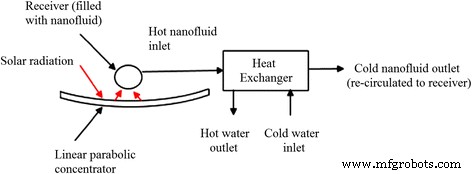
Schema van op nanovloeistof gebaseerd concentrerend zonnewaterverwarmingssysteem. Opnieuw getekend op basis van referentie [83]
Ook het theoretisch onderzoek naar de prestaties van een zonnecollector met behulp van nanovloeistoffen is de afgelopen jaren ontwikkeld. Alim et al. [86] bestudeerde theoretisch de entropiegeneratie, warmteoverdrachtskarakteristieken en de drukval van Al2 O3 , CuO, SiO2 , en TiO2 nanovloeistoffen in een vlakke plaat zonnecollector onder laminaire stroming. Ze ontdekten dat alle soorten nanovloeistoffen de prestaties kunnen verbeteren, terwijl de wrijvingsfactor bijna vergelijkbaar was met die van vloeistof op waterbasis. Faizal et al. [87] voerde ook een numeriek onderzoek uit naar de prestaties van die vier soorten nanovloeistoffen in de zonnecollector. Ze merkten op dat de energiebesparing van alle vier de soorten nanovloeistoffen meer dan 20% kan bedragen, wat zou resulteren in een vermindering van de uitstoot van broeikasgassen.
De prestatieverbetering door nanovloeistoffen in zonnecollectoren wordt over het algemeen toegeschreven aan twee primaire factoren:de verbeterde warmteoverdrachtskenmerken en optische eigenschappen. Daarom werden ook de optische eigenschappen van nanovloeistoffen in het zonne-absorptiesysteem onderzocht door onderzoekers. Said et al. [88] voerde zowel experimentele als analytische onderzoeken uit naar de zonneabsorptieprestaties van TiO2 en Al2 O3 nanovloeistoffen. Ze gebruikten twee volumefracties van 0,1 tot 0,3 vol.% voor het onderzoek naar lichtgevoelige eigenschappen. Sommige klassieke theorieën, waaronder de benaderingen van Rayleigh, Maxwell-Garnett en Lambert-Beer, werden in hun analytische analyse overgenomen. Ze concludeerden dat de optische eigenschappen van TiO2 nanovloeistoffen waren hoger dan die van Al2 O3 nanovloeistoffen binnen het bereik van zichtbaar licht voor alle deeltjeslading. Hij et al. [89] vergeleek de licht-warmteconversie-efficiëntie van de TiO2 –water en CNT–water nanovloeistoffen in een geëvacueerde buis zonnecollector in zowel zonnige als bewolkte omstandigheden. Ze merkten op dat de temperatuurstijging van CNT-water nanovloeistof hoger is dan die van TiO2 –water nanovloeistoffen, wat aangaf dat de licht-warmte-omzettingskarakteristiek van de eerste beter is dan de laatste.
Said et al. [90] dacht dat het meeste onderzoek was gericht op de fundamentele thermofysische en optische eigenschappen van nanovloeistoffen; de onderzoeken naar een belangrijke factor voor verstrooiing en absorptie, waaronder deeltjesgrootte, vorm en inhoud, evenals het type basisvloeistof, werden zelden gevonden. Om die factoren te onderzoeken, voerden ze gerelateerd onderzoek uit en merkten op dat de deeltjesgrootte weinig effect heeft onder de 20 nm, en dat het deeltjesgehalte recht evenredig was met de extinctiecoëfficiënt. Voor de nanovloeistoffen die 20 nm TiO2 . bevatten nanodeeltjes was de doorlaatbaarheid bijna nul voor golflengten van 200 tot 300 nm, maar respectievelijk 71% voor 400 nm en 88% voor 900 nm. Ze suggereerden ook dat de volumefractie van TiO2 nanodeeltjes moeten lager zijn dan 0,1%, waarbij een veel beter resultaat kan worden verkregen.
Kim et al. [91] voerde een gedetailleerd theoretisch onderzoek uit met behulp van MWCNT, Al2 O3 , CuO, SiO2 , en TiO2 nanovloeistoffen met PG (propyleenglycol)-water (20:80) basisvloeistof in een zonnecollector met U-buis op hoge temperatuur. Ze merkten op dat het collectorrendement van het zonnecollectorrendement een duidelijk positieve correlatie heeft met de thermische geleidbaarheid van toegevoegde nanodeeltjes, aangezien het in de volgorde van groot naar klein is:MWCNT, CuO, Al2 O3 , TiO2 , en SiO2 nanovloeistoffen. Ze analyseerden ook de emissiereductie van CO2 en SO2 evenals het elektriciteits- en energieverbruik wereldwijd. Hun resultaten ondersteunen dat nanovloeistoffen een groot potentieel hebben voor energiebesparing en emissiereductie. Omdat hun theoretische resultaten geen rekening hebben gehouden met de verspreidingssituatie van verschillende nanovloeistoffen, moeten de daadwerkelijke prestaties experimenteel worden geverifieerd.
Toevallig werd een soortgelijke experimentele studie van vlakke plaat zonnecollector met verschillende nanovloeistoffen uitgevoerd door Verma et al. [92]. De experimentele resultaten gaven aan dat voor slechts 0,75% deeltjesvolumelading en bij een stroomsnelheid van 0,025 kg / s, de exergie-efficiëntie van nanovloeistoffen in vergelijking met water wordt verhoogd met respectievelijk 29,32, 21,46, 16,67, 10,86, 6,97 en 5,74% voor grafeen , CuO, Al2 O3 , TiO2 , en SiO2 nanovloeistoffen. Ook volgde de daling in entropiegeneratie deze volgorde. Hun resultaten ondersteunden ook dat de efficiëntie van de zonnecollector een positieve correlatie heeft met de thermische geleidbaarheid van toegevoegde nanodeeltjes.
Er zijn echter ook enkele onderzoeken die verschillende resultaten opleveren. Mahian et al. [93] analyseerde de prestaties van een op minikanaal gebaseerde zonnecollector met behulp van vier verschillende waternanovloeistoffen met Cu, Al2 O3 , TiO2 , en SiO2 respectievelijk nanodeeltjes. Hun resultaten toonden de Al2 O3 nanovloeistoffen vertoonden de hoogste warmteoverdrachtscoëfficiënt, terwijl de laagste waarde toebehoorde aan SiO2 –water nanovloeistoffen, maar de uitlaattemperatuur volgde deze volgorde:Cu> TiO2> Al2 O3> SiO2 nanovloeistoffen. Ze merkten ook op dat entropiegeneratie van TiO2 –water is lager dan dat van Al2 O3 -water nanovloeistoffen ondanks de thermische geleidbaarheid van de eerste is lager dan de laatste.
Refrigeration
Nano-refrigerant is a special kind of nanofluid which consists of nanoparticles and refrigerant as well as the probable lubricant. Nano-refrigerant is a new generation of refrigerant for using compression or absorption refrigeration, air conditioning systems, heat pumps, etc. In recent years, many studies regarding nano-refrigerants have shown that adding nanoparticles into refrigerants or lubricant can achieve a better system performance and energy efficiency.
Table 2 shows summary of related studies on TiO2 nanoparticle-based nano-refrigerants. It can be seen that the TiO2 nanoparticles can work normally and safely with many kinds of refrigerants, including R134a, R600a, R436a, R436b, R141b, R123, R12, R22, and R410a. It can be seen that most results showed that adding TiO2 nanoparticles could bring benefits to the refrigeration system and the lubricating oil system, such as improving the performance [94], reducing the energy consumption [95,96,97], and the irreversibility [98]. Also, some research focused on the heat transfer [99, 100] and pressure drop [101] of the nano-refrigerant system to investigate the effect mechanism of the nanoparticles. Li et al. [102] investigated the coefficient of performance (COP) of the refrigeration system for both the cooling cycle and heating cycle, and the results showed that adding TiO2 nanoparticle would lead to a slight decrease in COP of the cooling cycle but a significant increase in COP of the heating cycle based on the power consumption of the compression. Bi et al. [96] experimentally investigated the reliability and performance of a domestic refrigerator with HFC134a as refrigerant and Mineral oil with TiO2 nanoparticles mixtures as lubricant. As illustrated in Fig. 7, the system main consists of fresh food storage room and frozen food storage room as well as refrigeration system pipelines. The results showed that the system TiO2 nanoparticles works normally and safely and adding 0.1 wt.% TiO2 nanoparticles can reduce 26.1% energy consumption while particle type has little effect on performance.
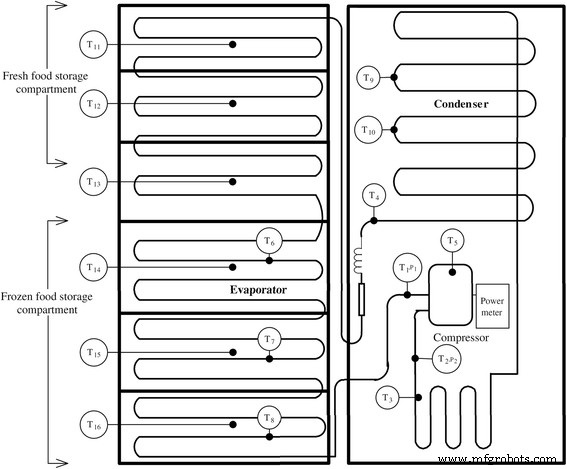
Schematic diagram of a domestic refrigerator with HFC134a, mineral oil and TiO2 nanoparticles [96]. Reproduced with permission from Elsevier
In addition, there is likewise a forward-looking study on the effect on the environment. Javadi and Saidur [103] observed that adding 0.1% of TiO2 nanoparticles to mineral oil-R134a could result in the maximum energy savings of 25% and reduce the CO2 emission by 7 million tons by year of 2030 in Malaysia.
It can be seen from Table 2 that the amounts of nanoparticles used in refrigerants were very low as below 0.1% [94,95,96,97,98,99,100,101,102,103], which can prevent clogging by the possible sedimentation of nanoparticles. However, although all results seemed positive, the long-term performance of the refrigeration system using nano-refrigerants is a great challenge.
Lin et al. [15] investigated the suspending ratio of (0.1 to 1%) nanolubricant–refrigerant after continuous alternation processes of condensation and evaporation. The schematic diagram and photographic view of their experimental system is shown in Fig. 8. They found that the degradation ratio was 28 to 73% after 20 times’ alternate operations. Also, they found lower particle loading can reduce the degradation speed. It can be concluded that the longtime performance of nano-refrigerant system is the essential step for further application in nano-refrigeration system.
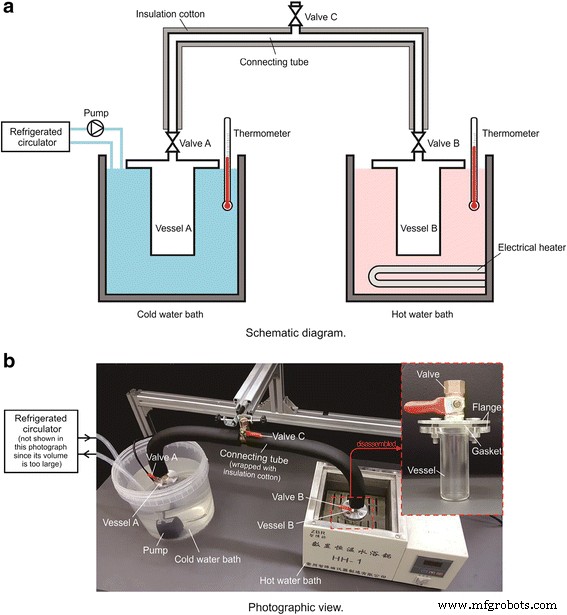
een , b Experimental setup for condensation–evaporation alternation [15]. Reproduced with permission from Elsevier
Energy Storage
The storage of latent heat is through the most efficient mean of storing thermal energy. The conventional PCMs have a shortcoming of inadequate heat transfer performance which can reduce the rate of storing and releasing thermal energy. Therefore, some researchers have studied the method of improving the heat transfer performance by adding nanoparticles into PCMs.
Usages of PCMs mainly include energy storage of heating or cooling capacity. Research on cool storage application of TiO2 nano-PCMs is relatively rare. Liu et al. [104] find that thermal conductivity of saturated BaCl2 aqueous solution increases remarkably when adding a small amount of TiO2 nanoparticles. They found the thermal conductivity was increased by 15.65% as the TiO2 nanoparticle volume fraction was 1.13% at temperature of 15 °C. They thought this nanofluid is a good phase change materials (PCMs) with higher cool storage/supply capacity and rate compared with its base fluids, which exhibited good potential for being applied to cool storage as a substitute for conventional PCMs.
Another similar study was conducted by He et al. [105]. They also found the thermal conductivity of saturated BaCl2 aqueous solution can be distinctly enhanced by 12.76% when adding a small amount of TiO2 nanoparticles at −5 °C. Although decreases in the latent heat and specific heat and an increase in viscosity were found, those varieties have little effect on the cool storage system since the supercooling degree is reduced by 84.92%. They also thought that TiO2 -saturated BaCl2 aqueous solution is suitable for low-temperature energy storage industries.
Studies on cool storage of TiO2 nano-PCMs are in the minority, while most PCM applications focus on the heat storage. Table 3 shows a brief summary on the thermal conductivities and the latent heat of TiO2 nano-PCMs for thermal storage applications in existing literatures. Sharma et al. [106] prepared a composite of palmitic acid (PA) and TiO2 nanoparticles with SDBS as dispersant for thermal energy storage application. The preparation steps of PA–TiO2 composites are shown in Fig. 9. It can be observed that the dispersion methods including adding surfactant, stirring, and ultrasonic vibration were implemented under the condition that the temperature of the base PA is above the melting temperature to confirm its liquid state.
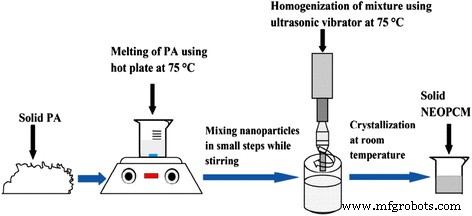
Preparation steps of PA–TiO2 composites [106]. Reproduced with permission from Elsevier
Their results showed that the thermal conductivity increased by 12.7, 20.6, 46.6, and 80% when the mass fractions of TiO2 nanoparticle were 0.5, 1, 3, and 5%, respectively. And they considered this PCM could be a good candidate as potential solar thermal energy storage materials due to its high latent heat and thermal reliability of palmitic acid. Harikrishnan et al. [107] dispersed TiO2 nanoparticles into PCM stearic acid and found this composite can accelerate the melting and solidification rates due to the enhanced heat transfer performance. They also observed that the addition of 0.3% nano-TiO2 nanoparticles can increase the thermal conductivity of stearic acid by approximately 63%. In their another research [108], they used stearic acid and lauric as base PCM and found an increment of 42% in thermal conductivity and a reduction of only 2% of latent heat of fusion. Motahar et al. [109] dispersed the TiO2 nanoparticles into organic PCM n-octadecane and found that the maximum enhancements of thermal conductivity in solid and liquid phases occurred at 3 and 4 wt.%, respectively. Moreover, the maximum average thermal conductivity enhancement for both phases was 26.6% when loading 5 wt.% nanoparticles.
Another experimental research focusing on the solidification process of PCM containing TiO2 nanoparticles was also performed by Motahar et al. [110]. They observed that the rheological behavior of liquid PCM–TiO2 at higher loading tends to Bingham fluids so that their solidification experiments were performed within 0–2.17 Bingham numbers. The results showed that the addition of TiO2 nanoparticles can enhance the thermal conduction process and hence increase the solidified volume. For particle mass loading of 1, 2, and 4%, the solidified volume fraction was increased by 7, 9, and 18%, respectively. At last, they proposed a universal correlation to predict the solidified volume fraction as a function of Fourier number, Rayleigh number, solid Stefan number, Bingham number, and particle loading.
Most of the results showed that when adding TiO2 nanoparticles, the thermal conductivity of PCMs can be greatly increased, while the latent heat will be decreased slightly, which is probably as a result of the thermal conductivity of nanoparticles which is much larger than the base composite, while the nanoparticles will not take part in the phase changing process as the base composite. However, in some case, both of the thermal conductivity and latent heat capacity of PCMs were considered to be elevated. Wang et al. [111] prepared nano-PCMs by adding TiO2 nanoparticles into paraffin. They found the addition of TiO2 nanoparticles can change the phase transition temperature and latent heat capacity of paraffin. The phase transition temperature dropped with <1% loading, while increased with>2% loading of particles. The latent heat increased firstly and then decreased as the loading of particles increase. And the turning concentration is 0.7 wt.%, at which a maximum latent heat capacity can be achieved. While the thermal conductivity of the nano-PCMs increased monotonously with the loading of TiO2 nanoparticles. When the loading of TiO2 nanoparticles reached 7 wt.%, the thermal conductivity was increased by 13% but the latent heat was reduced by 9%.
Heat Pipes
The characteristics of boiling heat transfer and critical heat flux enhancement of nanofluids can be utilized in the heat pipe to improve its performance and broaden the application range. And some numerical results [112, 113] have shown that for thermosyphon heat pipe, using the nanofluid could achieve a better heat transfer characteristics. Also, some researchers have carried out related research using TiO2 nanofluids.
Zhou et al. [114] tested gravity heat pipes filled with DI water and TiO2 nanofluids, where the concentration and filling ratio of nanoparticles were varied and the initial temperature distribution was given. The result indicated that the heat pipes filled with nanofluids had a lower start-up temperature and a shorter start-up time in evaporation section under the condition of a water bath. And the biggest temperature drop between the evaporation section and the condensation section for heat pipes filled with TiO2 nanofluids was lower than those filled with DI water. The start-up time of heat pipes with filling ratios ranged between 50 and 70% in the evaporation section increased with the increase of the filling ratio and heating temperature, but the small inclination angle had a negative effect on the start-up performance.
Saleh et al. [65] collected data from different nanofluid experiments, where particle volume loading was up to 1.0% and the temperature of measurements ranged from 10 to 60 °C. They discovered that these data agreed with the classical Brownian motion theoretical model. They also investigated experimentally the effect of nanofluids on the thermal performance of heat pipes by measuring the wall temperature and thermal resistance distributions between the evaporation and condensation section. They found that distilled water and nanofluids achieved the best heat transfer performance when the inclination was set to 45° and the charge volume ratio of working fluid was 60%.
In 2015, Monirimanesh et al. [115] designed a thermosyphon-type heat pipe heat exchanger (HPHX) using TiO2 nanofluids as the working fluid to save energy in an air conditioning system. Their experimental apparatus was constructed as shown in Fig. 10. They establish a pre-cooling and pre-heating device to produce altered conditions of the inlet air for investigating the performance of HPHX. The evaporator and condenser section of the HPHX functioned as a pre-cooler and reheating coil for the air conditioning system respectively. They also employed an electric heater and electric boiler to supply heat and steam into the entered fresh air by a fan for the purpose of simulating the hot and humid climate. Their results showed that using TiO2 nanofluids and increasing the HPHX number of rows could make a part of air condensed on the evaporator fin, which could enhance the energy in the pre-cooling section. The use of 3 wt.% TiO2 –methanol nanofluids in a four-row HPHX could achieve the highest energy savings ranging from 30.6 to 32.8% when the inlet air under the properties of 45 °C and 50–74% relative humidity. Based on a comprehensive consideration of the main purpose of supplying the energy required for reheating, they suggested that 2 wt.% TiO2 –methanol nanofluid for the four-row HPHX would have been adequate and more economical.
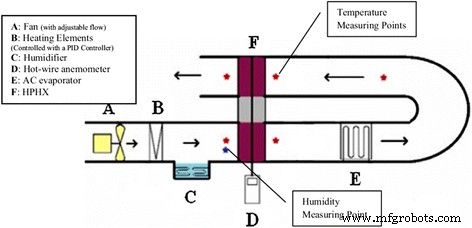
Schematic of the experimental apparatus [115]. Reproduced with permission from Springer
Mass Transfer
The mass transfer of nanofluids is another important application aspect of TiO2 nanofluids. Current research has shown that TiO2 nanofluids can be used to enhance the absorption process of CO2 and NH3 as well as the mass transfer coefficient of electrolyte fluids.
Li et al. [116] prepared stable N -methyldiethanolamine (MDEA)-based nanofluids to strengthen the absorption performance of CO2 in the MDEA solution. The CO2 absorption characteristics in the gas/liquid interface of nanofluids were investigated by measuring the absolute pressure drop of gas. The mass fraction of MDEA was 50%. And they used two particle mass fractions of 0.1 and 0.4%. The results showed that the CO2 absorption rate increases with increasing temperature and it is enhanced by the added nanoparticles. However, at 20 and 30 °C, the enhancement caused by the mass fraction of nanoparticle (0.1 and 0.4%) reduced gradually. The effective absorption ratio varied from 1.03 to 1.14. Also, CO2 bubble absorption ratio increased with the increase of nanoparticle mass fraction.
Yang [117] prepared stable TiO2 nanofluids without adding dispersant and then carried out a comparative experiment on the falling film performance of absorption of ammonia gas by nanofluids and pure water. The schematic diagram of the experimental system for NH3 –H2 O nanofluid falling film absorption is shown in Fig. 11. They found that the absorption rate of ammonia gas can be increased by 10% when adding anatase TiO2 nanofluids. Wu [118] used the similar experimental device but changed the falling film tube of Fig. 11 into a fin tube. He investigated the effect of rutile TiO2 nanofluids on the ammonia absorption performance of falling film outside a fin tube. The result showed that the combined use of zigzag tubule and TiO2 nanofluids can strengthen the ammonia–water falling film absorption and the maximum increment can reach 60.8%.
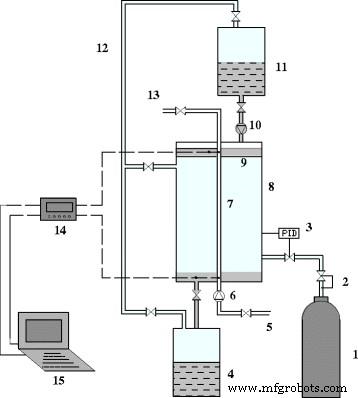
Schematic diagram of the experimental system for NH3 –H2 O nanofluid falling film absorption [117]. 1 NH3 vessel, 2 decompression valve, 3 constant pressure controller, 4 , 11 container of solution, 5 inlet of cooling water, 6 , 10 constant flow controller, 7 falling film tube, 8 visible absorber body, 9 solution distributor, 12 tubes for balancing pressure, 13 outlet of cooling water, 14 HP data acquisition instrument, 15 computer
Beiki et al. [119] investigated experimentally the turbulent mass transfer characteristics of TiO2 and γ-Al2 O3 electrolyte nanofluids in a circular tube. The results showed that adding 0.015 vol.% TiO2 and 0.01 vol.% γ-Al2 O3 could bring an increase in mass transfer coefficient of the electrolyte solution by 18 and 10%, respectively. They found that the enhancement ratio was independent of Reynolds number. The mass transfer coefficients increased firstly and then decreased as the nanoparticle loading increase. They attributed the cause of the existing of optimal particles’ loading to the clustering of nanoparticles and forming bigger agglomerates with smaller Brownian velocity when exceeding the optimum loading.
Coolant of Milling
As a coolant, nanofluids’ heat transfer enhancement characteristic can improve the cooling performance [120]. Moreover, when nanofluids are used for milling, another characteristic of nanofluids viz. enhancement in wear resistance can also play an important role in extending the lifetime of the milling tool.
Yogeswaran et al. [121] investigated experimentally the effects of coolant of TiO2 –EG nanofluid on the tool wear and workpiece temperature at the various milling conditions when used for milling a stainless steel AISI 304. The milling tool was made of a TiN-coated carbide insert. The results showed that comparing to pure base fluid, the workpiece temperature was reduced by 30% when using the nanofluid as coolant. The tool wear from milling using the EG-based TiO2 nano-coolant is much less than using the normal commercial coolant because the nanofluids can reduce the heat penetrating into the inserts. And the tool life is increased as a result of the nanoparticles reduces the damage on the edge of the tool.
Muthusamy et al. [122] also compared the efficiency of nanoparticle-based coolant (TiO2 –EG) and conventional water-soluble coolant on the tool life and wear performance of a TiN-coated carbide insert in the end-milling process of AISI304 stainless steel. The results showed that using TiO2 –EG nanofluid as coolant could increase the tool life from 32.67 to 54.9 min (increased by 40.55%) comparing to that using TiO2 –EG nanofluid as coolant instead of water-soluble coolant. They attributed the cause to a Ti nanoparticle layer on the edge of the insert formed during the milling process when using TiO2 –EG nanofluid, which can be proved from the SEM and EDX of cutting edge as shown in Fig. 12. When using nanofluids as coolant, the oxidation still occurred despite the cutting temperature was reduced at the interface of the tool and workpiece since it can be found from Fig. 12 the O peak on the EDX spectrum. The hard oxidation layer was formed due to the entering of oxygen from TiO2 –EG nanofluid into the tool–workpiece interface. Then, the hard oxidation layer can protect the tool from micro-cracking and chipping wear because it could not be easily detached despite under the severe impact of the milling force and took parts of the tool surface from the workpiece.
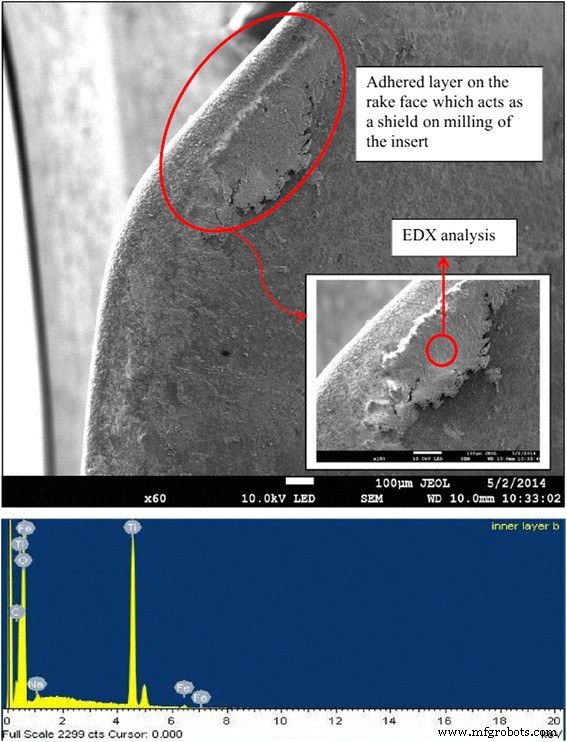
SEM and EDX of cutting edge [122]. At a cutting speed of 1500 rpm, feed rate of 0.02-mm tooth, and axial depth of 0.1 mm using nanoparticle-based coolant at a cutting distance of 180 mm (×60 magnification). Reproduced with permission from Springer
Challenges and Future Works
Challenges
The above energy-related examples have exhibited the extensive application prospect and excellent properties of TiO2 nanofluids. Although in some cases, especially in heat transfer applications, the heat transfer performance of TiO2 nanofluids are not better than that of Ag, Cu, and CNT nanofluids, TiO2 nanofluid is also a good choice due to their comprehensive properties for instance better dispersion and chemical stability, security, and economy.
Although TiO2 nanofluids have showed great enhancement in heat transfer of solar collectors, refrigeration, energy storage, heat pipes, and coolant of milling, the investigations on the performances including dispersion stability and heat transfer performance after running operations are in great lack. Most dispersion stability studies are in static conditions, but it is important that the nanofluids prepared should be treated in the practical application conditions to examine the dynamic cycle stability and the sustainability of both system performance and components of nanofluids.
Generally, the biggest downside in application of nanofluids is the sedimentation and degeneration of nanoparticles after long running which makes the long-term performances of nanofluid system challenged. Some researchers have proposed a new idea and a novel method to re-disperse the aggregates in real time of the running system [123]. However, the concrete effect of the device has to be verified experimentally, and then, the design and location of the re-dispersion device needs to be improved. The surfactant is expected to have positive effect on the re-dispersion characteristic of aggregates. However, one of the biggest flaws in using surfactants is the occurrence of foaming when the fluids are under flowing or heating conditions which would have adverse impacts on the heat or mass transfer application of nanofluids. This defect suggests the amount of surfactant employed in the nanofluids should be limited.
Another great limitation in application of nanofluid is the increase in pumping power and pressure drop of nanofluids, which is essential for the high-quality application of solar collectors, refrigeration, and heat pipes. For instance, Sajadi and Kazemi [124] found the proportional increase in pressure drop of TiO2 nanofluids is higher than that of heat transfer coefficient. While Teng et al. [125] found the pressure drop proportion of TiO2 nanofluids for turbulent flow is lower than that for laminar flow. Therefore, if the extra energy consumption by the increased viscosity of nanofluids exceeds the benefit from the heat or mass transfer enhancement, there will be no application prospect. The most extreme case is when a large amount of agglomerations emerge, the pumping power and pressure drop of nanofluids will be greatly increased, which might lead to serious impact on system performance. Moreover, based on the similarity principle in heat transfer study, for instance in forced convection process, Nusselt number is determined by Reynolds number and Prandtl number, different thermal conductivity and viscosity will induce different Nu even though for the same experimental heat transfer coefficient. Therefore, the properties of nanofluids are essential for quantitative study in those application fields.
Future Works
As a widely used material in considerable fields, TiO2 has been explored several hundred years, and its nanofluidic form is also firmly worth studying and expected to make greater contributions owing to the outstanding physical and chemical properties. This paper provides a summary of the research outcomes of TiO2 nanofluids up to now, including the preparation and stability of TiO2 as well as three vital properties of TiO2 nanofluids. It can be concluded that TiO2 nanofluids show very comprehensive applications in heat transfer or other energy fields due to their good dispersion stability in both hydrophilic and lipophilic liquids, nontoxic and non-corrosive natures, chemical stability, lower price, and good appearance. Therefore, TiO2 nanofluid is thought as one of the closest kinds to practical industrial application environment because of their better dispersion and chemical stability, security, and economy.
However, although TiO2 nanofluids have shown enormously exciting potential applications, before commercialization of nanofluids, some urgent problems are summarized as follows:
Firstly, acquiring high-quantity nanofluid with outstanding long-term and high-temperature stability is the fundamental of the entire research since in any practical application, it is essential to have a stable suspension.
Secondly, the way to enhance and keep the stability of nanofluids in real time is a key issue in the actual use since the sedimentations of nanoparticles seem inevitable after a long-term running. The method to re-disperse the aggregation of nanoparticles in real time by adding some dispersion device in the system with functions of ultrasound or agitation might be a useful option [123].
Thirdly, although the surfactants were used to improve the dispersion and adhesion performance of nanoparticles in liquid, the effect of surfactants on the physical properties and system performance needs to be investigated. The amount of surfactants should be investigated experimentally owing to the positive and negative effects of surfactants.
Fourth, the pumping power or pressure drop of nanofluids is another challenge for the engineering application. Using nanofluids with higher viscosity than base fluids will induce a higher pressure drop and hence needs more pumping power [125]. The method to achieve higher heat transfer coefficient and lower pressure drop needs to be further studied.
Fifth, the waste management of the invalid nanofluids should also be considered when applying them to industrial systems. The impact on the environment by the nanofluids restricts many kinds of nanofluids containing heavy metal, toxic substance, or other hazardous substances. The super whiteness dyeing behavior of TiO2 nanofluids should also be noticed to prevent the environment getting contaminated.
Sixth, although some studies have analyzed the entropy generation in tubes [126], microchannels [127], sheet, and other types of flow [128, 129], the entropy generation characteristic of nanofluid in the full system is actually the most important parameter for the full-system application or designing.
Last but not least, there is lack of evaluation index on the performance of nanofluids, especially on the stability, adhesion, and property sustainability of nanofluids. There is no unified indicator to evaluate the stability and adhesion of nanofluids. The uniform evaluation indexes on the different properties of nanofluids are needed [130].
The above problems are urgently needed to solve for the further application of TiO2 nanofluids, which point out the directions of the future works in this field. It is believed that these problems and challenges will be solved or reduced with the development of nanofluid technology in the future.
Conclusions
This second part of the review summarizes recent research on application of TiO2 nanofluids and identifies the challenges and opportunities for the further exploration of TiO2 nanofluids. It can be concluded that although particle loading has exhibited a positive correlation with thermal conductivity of nanofluids, the effects of other factors including particle shape, size, base fluid type, temperature, surfactant, and sonication are unified. Even for particle loading effect, the intensities of growth in thermal conductivity differ widely for different samples. TiO2 nanofluids have shown good applications in many energy-related filed. However, the indeterminacy of long-term performances for both nanofluid and system and the increment in pressure drop are needed to investigate for further application. The forecast research hotspots are regarded as the long-term and high-temperature stability and re-disperse the aggregation of nanoparticles in real-time system, the required amount of surfactants, the heat transfer and pumping power characteristics, and the evaluation index on the stability, adhesion, and property sustainability of nanofluids.
Nanomaterialen
- Eigenschappen en toepassingen van tantaal
- Kenmerken en toepassingen van titanium
- Toepassingen van molybdeen en molybdeenlegeringen
- Arduino-sensor – Typen en toepassingen
- Werking en toepassingen van vingerafdruksensor
- Werking en toepassingen van de vibratiesensor
- Zuurstofsensor werkt en toepassingen
- Basisprincipes van ingesloten systemen en applicaties
- Toepassingen en beperkingen van genetische algoritmen
- Voordelen en toepassingen van Rapid Prototyping
- Industriële remmen:doel en toepassingen



